Where does fuel poverty exist?
Rates of fuel poverty vary drastically from country to country or even among communities within a country. Across the European Union (EU) for example, 46.5% of people in Bulgaria are unable to keep their homes adequately warm in winter, while rates in more northern countries are much lower - i.e. only 4.2% in Estonia, 2.6% in Denmark and 1.4% in Sweden. This week, COLD@HOME starts exploring causes of fuel poverty that reflect specific contexts, and examining why it is so important to apply fit-for-purpose solutions.
Depending on where one goes for statistics, it is estimated that between 50 million and 125 million people in Europe live in fuel poverty. At the high end, that's almost 20% of the total EU population of 508 million. But even thinking one in ten people have trouble affording enough energy to stay warm brings the problem close to 'next door' for all Europeans.
Except, of course, that averages are always a far cry from the best- and worst-case scenarios. And the average changed dramatically since 2004 when the European Union itself began expanding to include countries that emerged from the Former Soviet Union and the Mediterranean countries of Greece, Cyprus and Malta.
From the perspective of the European Commission (EC), fuel poverty is a serious form of the mix of general poverty and social exclusion that undermine the aim to secure smart, sustainable and inclusive growth across all economies. By 2020, the EC aims to reduce by 25% the number of European living below national poverty lines. For many, being lifted out of fuel poverty is an important first step. If narrows the scope of investigation to only those already at risk for general poverty, the rates of fuel poverty rise substantially. In Bulgaria, for example, 70% of people in general poverty are fuel poor.
While much work in the area of fuel poverty has the inability to keep homes adequately warm as the sole measure, the EC adds two more criteria: households that fall into arrears on their utility bills and those who live in defective dwellings (meaning they have leaky roofs, damaged walls or foundations, and conditions such as mould and rot).
Click to view interactive map
X
(close)
Countries with high levels of people living poverty have, not surprisingly, a high level of people who are in arrears on their utility bills. The highest rates of people falling behind on payments are in Greece (31.8%), Romania (28.6%) and Bulgaria (28.4%), with the rate in Greece having grown dramatically since the current economic crisis began in 2009. By contrast, only 2.2% of people in Luxembourg are behind on utility bill payments.
In fact, across Europe, the number of people at risk of poverty increased from 80 million to 125 million in just three years (from 2009-12). An area of future concern in this regard is the aging population in Europe: by 2050, the number of people over 65 will be double what it was in 1990. Many will be relying on pensions (i.e. have a lower income than when they were active in the workforce), and will likely need higher temperatures to stay comfortably warm for longer hours spent in the home from day to day. The elderly population is also most at risk for health impacts of fuel poverty. In short, without active intervention, the personal and societal burden of fuel poverty is likely to get worse in the future.
Click to view interactive map
X
(close)
Click to view interactive map
X
(close)
A similar correlation exists for general poverty and those who cannot keep their homes adequately warm. As mentioned above, this spikes to 70% in Bulgaria, where winters are quite severe. But the next highest levels for fuel poverty among the poor are in the Mediterranean countries of Cyprus (50.6%), Greece (47.6%) and Italy (44.1%). Portugal, Romania, Poland, Malta, Latvia and Lithuania all have rates above the EU average.
Among the general population, the highest rates of people living in homes with physical defects (notably a leaking roof, or damp walls, floors or foundation) are found in Slovenia (31.5%), Cyprus (30%) and Latvia (28.2%). In this case, narrowing the scope to those in poverty bumps Hungary (53%) into the top position while also substantially pushing up rates in Slovenia (46.1%) and Latvia (43.3%) and Cyprus (34.6%).
Taking into account all three indicators, Bulgaria, Cyprus and Greece are the countries with the most serious fuel poverty issues, while Sweden, The Netherlands, Denmark and Luxembourg have the least significant problems.
If the mismatch of income, energy prices and energy needs is the underlying cause of fuel poverty, it follows there are three main ways to tackle it: increasing incomes, implementing fuel price regulation or providing fuel subsidies, and undertaking fuel efficiency improvements in buildings. The EU position is clear:
"Vulnerable consumers are best protected from energy poverty through a full implementation by Member States of the Existing EU energy legislation and use of innovative energy efficiency solutions."
COLD@HOME will explore the pros and cons of each approach when we move on to solutions reporting in early April. But first, a survey of the specific situations in a range of EU countries.
This feature draws largely on data from Eurostat and analysis from the Buildings Performance Institute of Europe (BPIE), including Alleviating Fuel Poverty in the EU.


